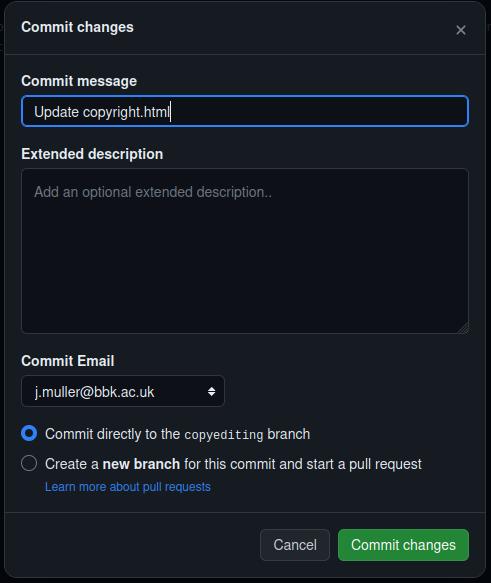Hourglass Theme for Janeway
Installing
-
Clone this repository into the theme folder of your Janeway installation:
cd src/themes git clone git@github.com:BirkbeckCTP/hourglass.git -
With your Python virtual environment activated, install the Python dependencies using pip.
pip install -r requirements.txt
-
Install the JavaScript dependencies using NPM:
npm install
You should see a new
node_modulesfile in thehourglassfolder. -
Add the app name to your
INSTALLED_APPSinsettings.py:INSTALLED_APPS = [ ..., 'themes.hourglass', ..., ]
-
Make changes to settings for
django-components, mostly according to the installation instructions However, do not apply caching withloaders.cached.loader. Instead, use these loaders:'loaders': [ 'utils.template_override_middleware.Loader', 'django.template.loaders.filesystem.Loader', 'django_components.template_loader.Loader', 'django.template.loaders.app_directories.Loader', ],
-
Make changes to settings for
django_minify_htmlif desired according to the installation instructions
Deploying to production
From the Janeway root, build assets for all themes:
python src/manage.py build_assetsYou can call the same command via NPM in the theme root:
cd src/themes/hourglass
npm run buildUpdating in production
cd src/themes/hourglass
git pull
pip install -r requirements.txt
npm install
python ../../manage.py build_assetsDeveloping
CSS
Use Tailwind classes in the HTML templates to apply styling.
In the rare case you need to apply a style to the base layer or define
a custom component, make changes to src/input.css using @layer and
@apply commands.
When making lots of small CSS changes that you want to see in the browser during development, you can use the hot replacement (HMR) feature provided by Tailwind. To watch for changes and recompile the CSS based on classes used automatically, use this NPM command:
npm run devThis should work smoothly with the django-browser-reload configuration
in Janeway so that you only have to save the HTML file you’re working in
to see the changes take place in the browser. Templates and static CSS
files are both watched and can trigger reloads independently.
Styling notes
Each section of content is given a container and relative positioning, so that it can be used as an anchor for background colors and images.
Z-index is used as follows:
-
-z-10for the solid light tan background -
z-0,z-10, andz-20for the constructivist collages of geometric shapes and cut-out photos -
z-30for pseudo-elements used to extend alternate color backgrounds outside the container to the edge left and/or right -
z-40for the content layer, along with its immediate, in-container background color -
z-50for the sticky desktop nav so it is persistent on top of everything else
JavaScript
Modify the files in js and rerun build_assets.
New files need to be added to OTHER_SOURCE_FILES in build_assets.py.
Code styling and linting
The repository is set up with a few formatters and linters:
-
Standard for JavaScript
-
djhtml for Django template file indentation, using 2-space-indents to better handle long Tailwind class lines
Please run these two commands before pushing:
standard --fix
djhtml --tabwidth 2 templatesWe haven’t enforced them as a pre-commit hook, because we’d need to discuss the implications of that first.
Copyediting and Content Changes
All the content for this theme is stored in GitHub, rather the Janeway content management system. You can propose changes in GitHub by following these steps:
-
Make sure you have a GitHub account and that you’ve been added to an OLH GitHub team with the right access.
-
Make sure you have a Janeway account for the installation that you want to edit and that your account has staff access.
-
While logged in to the website, find the live page you want to edit, and click on the “Edit on GitHub” link. You should be taken to the GitHub page with the source code. You should also see the name of the branch at the top of the page, after the file path.
-
Edit the file, and then select “Commit changes”. Enter a commit message, and leave “Commit directly to the copyediting branch” selected. Select “Commit changes”.
-
Open a pull request from the copyediting branch to the main branch. Or just ask a member of the tech team to do so for you. They will review your edits and merge them into the live version of the website.
Changing a link to a media file
You can change a hyperlink to a Word doc or PDF like this:
-
Upload the new file to the appropriate Media Manager in Janeway.
-
Copy the link Janeway gives you, and then paste it in to the appropriate page using the steps above for Copyediting and Content Changes. For example, in this line, you'd just replace the whole URL from "https" to ".doc". Keep the quotes around the link.
Engineering
As an alternative, we could use django-tailwind.
Licensing
The code in this repository is licensed under AGPL 3.0.
Unless otherwise stated, the original textual content and visual designs in this repository are the copyright of Birkbeck, University of London, and they are licenced under a Creative Commons Attribution 4.0 International License (CC BY 4.0). The Open Library of Humanities and its logos are registered trademarks.
The attribution-required and trademarked content is restricted to the following folders:
-
templates/custom/* -
components/* -
src/media/*
The CC BY license lets you share and adapt these materials so long as you properly credit the source. Proper attribution of the OLH must be given in the following manner:
-
Attribute the materials wherever they appear, including published end-product websites.
-
Spell out the full name of the Open Library of Humanities and provide a link to our website, as in one of these examples:
-
“The Open Access Movement” was first published by the Open Library of Humanities, openlibhums.org
-
Diamond open access diagram by the Open Library of Humanities
-
-
Display the attribution so that it is clearly visible and easily legible, not obscured or hidden, with text that is the same size as the main text in your work, or a minimum of 12pt (print) or 18px (web), whichever is larger
-
Under no circumstances may your use or attribution of our materials misconstrue the Open Library of Humanities as a publisher of your works

